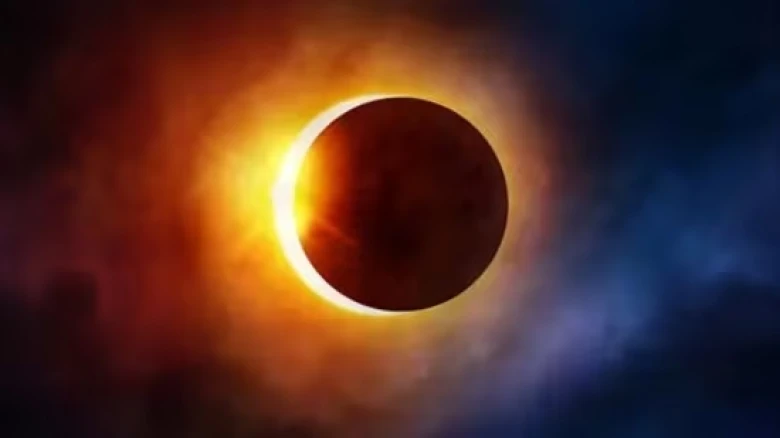The western and northern regions of New York State will witness a total eclipse for the first time in nearly a century..........
Digital desk: Today is a total solar eclipse, which will be seen across large portions of North America but will not be captured by Aditya L1, India's first space-based solar observatory, which is constantly monitoring the Sun. Many activities are being planned to observe the celestial spectacle, which is an uncommon occurrence for humans in the USA: skydiving and special flights.
The western and northern regions of New York State will witness a total eclipse for the first time in nearly a century. The USA is in excitement as the Moon crosses towns along its "path of totality," a short section where the Moon completely blocks out the Sun.
In its statement about the event, NASA says, "On April 8, 2024, a total solar eclipse will cross North America, passing over Mexico, the United States, and Canada. A total solar eclipse happens when the Moon passes between the Sun and Earth, completely blocking the face of the Sun. The sky will darken as if it were dawn or dusk."
NASA is also flying special research planes to chase the shadow among many other experiments. The main spectacle, the transition from day to night, should only endure for approximately four minutes during the several hours that the event will last in complete darkness.
However, the event will not be seen on India's Aditya L1 satellite. This isn't because the Indian Space Research Organization (ISRO) made a mistake; rather, but because the satellite is placed appropriately at a location that provides an uninterrupted 24x7, 365-day view of the Sun. The position of the satellite was selected by Indian scientists to guarantee that an eclipse would never block the satellite's view.
"Aditya L1 spacecraft will not see the solar eclipse as the moon is behind the spacecraft, at the Lagrange Point 1 (L1 point), the eclipse that is visible on Earth doesn't have much significance at that location," ISRO chairman S. Somanath told NDTV.
Around 1.5 million kilometers from Earth, close to Lagrange point 1 (L1) of the Sun-Earth system, is where the Indian Aditya L1 spacecraft is positioned in a halo orbit. The main benefit of having a satellite in the halo orbit around the L1 point is being able to view the Sun continually without being obscured by clouds or eclipsed by sunlight. This offers an even bigger benefit of real-time monitoring of solar activity and its impact on space weather.
Aditya L1 is a robotic study satellite designed to monitor the Sun continuously. It is around 1,500 kg in weight. This is the first mission from India specifically designed to monitor the Sun and learn more about what occurs when the Sun gets active. The construction of the solar observatory came for Rs. 400 crore.
The Visible Emission Line Coronagraph (VELC), a unique sensor on board the Aditya L1 satellite, allows the spacecraft to efficiently study the Sun by creating its fake solar eclipse. According to Mr. Somanath, "A solar eclipse is created in the coronagraph by eliminating the light from the disc of the Sun."
Solar physicist Dr. Dipankar Banerjee of the Indian Institute of Astrophysics (IIAP), Bengaluru, said the spacecraft gives scientists a chance to see and examine the Sun's corona both from space and during a total solar eclipse.
During today's eclipse, Dr. Banerjee will be doing some ground-based experiments in Dallas, Texas, USA. The data from these tests will be compared with Aditya L1 data collected during the same viewing period.
Nigar Shaji, the Project Director for the Aditya L1 satellite from ISRO, says that nothing will change in the Sun due to the eclipse.
Shaji in a report says, "Due to the eclipse, nothing special happens to the Sun. The VELC spectroscopic channels will be operated in raster scan and sit and stare mode of operation [special observation modes] to observe the coronal structures in emission lines. This will be a joint campaign to corroborate with ground-based observations."
Aditya L1 is equipped with seven payloads that use electromagnetic, particle, and magnetic field detectors to study the photosphere, chromosphere, and the outermost layers of the Sun called the corona. The remaining three payloads conduct in-situ investigations of particles and fields at the Lagrange point L1, so enabling significant scientific studies of the effect of solar dynamics in the interplanetary medium. Four payloads use the unique vantage point L1 to directly view the Sun.
NASA says, "Except during the brief total phase of a total solar eclipse, when the Moon completely blocks the Sun's bright face, it is not safe to look directly at the Sun without specialized eye protection for solar viewing. Viewing any part of the bright Sun through a camera lens, binoculars, or a telescope without a special-purpose solar filter secured over the front of the optics will instantly cause severe eye injury."

Leave A Comment